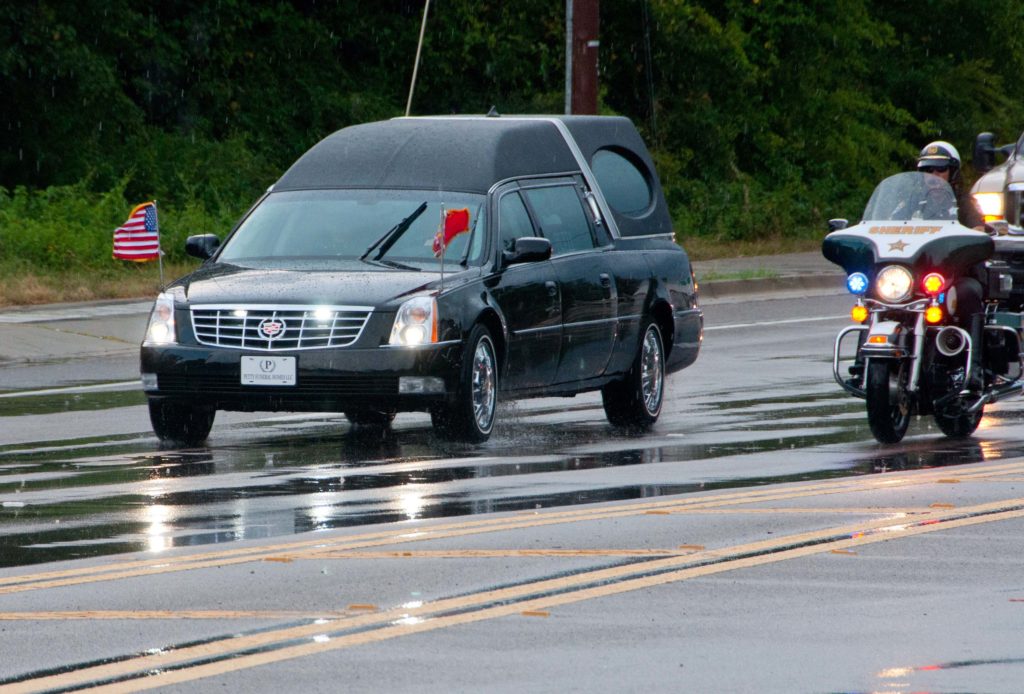While there isn’t a specific statute prohibiting the passing of a funeral procession, there are several driving laws that should be considered in this discussion. Driving laws in Nevada are found in NRS Chapter 484. There are several statutes that address funeral processions and passing of other vehicles. We’ll review both.
Funeral Processions in Nevada
Funeral processions are defined under Nevada law as two or more vehicles accompanying a vehicle containing the body of a deceased person.
Certain privileges are given to escorts of funeral processions. These are found in NRS 484B.700. In fact, Nevada is unique among the states in allowing funeral procession escorts to run red lights or stop signs, to direct traffic to allow passage of a funeral procession. They are expected to do so safely and are required to have flashing amber lights and/or audible signals in doing so. Funeral procession escorts are also allowed to exceed the speed limit by 15 MPH to catch up with the front of the procession to direct traffic at the next intersection or traffic signal and can drive the wrong direction for the same reason. Escorts are not required to be police officers, although many are off-duty officers.
Vehicles in a Funeral Procession are required to all have headlights on, and may display flags or other insignia to designate them as a part of the procession. Vehicles in the procession are to follow the preceding vehicles as closely as is practical and safe. It is prohibited for vehicles not in the procession to drive through the procession or to drive in between the vehicles in the procession.
Passing Laws in Nevada
Nevada laws regarding passing are found in NRS 484B.200-484B.277. A summary of laws governing passing that are relevant to our discussion are as follows:
All passing must be done without breaking the posted speed limit
Passing on the left:
On a two lane, two directional road passing is allowed if:
- If another lane is clear and visible and distance allows for pass to take place before without interfering with oncoming traffic;
- If not within 100’ of the crest of a hill;
- If not within 100’ of an intersection or railroad crossing;
- If not within 100’ of a view-obstructing bridge, viaduct, or tunnel;
- If not marked as a NO PASSING zone by signage or unbroken yellow line.
On a road with two or more marked travel lanes going the same direction, passing is allowed if:
- If you signal your intent to change lanes;
- You have ascertained that the pass can take place safely.
Passing on the right:
On a two lane two directional road passing is allowed if:
- Person in front of you is signaling or making a left turn;
- Paved but unmarked roadway is wide enough to allow for two vehicles in each direction;
- No vehicles are parked in that unmarked pavement;
- Travel in unmarked pavement is not more than 200’;
- Travel in unmarked pavement does not include an intersection or driveway;
- You may not pass where it is unpaved.
On a road with two or more marked travel lanes going the same direction, passing is allowed if:
- If you signal your intent to change lanes;
- You have ascertained that the pass can take place safely.
Is it legal to pass a funeral procession?
It would depend on the length of the procession and the speed at which the procession is traveling, and whether you are traveling on a bi-directional road, or on a road with multiple lanes in each direction. Since it is prohibited to cut into a funeral procession, the entire procession should be considered a single vehicle, and judgments regarding passing it should reflect that. Beyond that, one purpose of the procession is to show respect for the dead, and judgments regarding passing the procession should take that into account as well.
Ticket Busters is here to help
All drivers are responsible for driving safely without endangering others they share the road with. Sometimes things go wrong, and you get caught breaking the speed limit. When this happens, call Ticket Busters to assist. If this has happened to you, call us today at (702) 666-6666.



